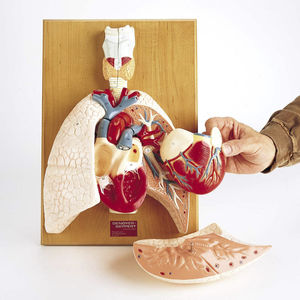
- Primary care
- General practice
- Trachea model
- Denoyer-Geppert

- Products
- Catalogs
- News & Trends
- Exhibitions
Vena cava model 0101-00sinusheartcardiac
Add to favorites
Compare this product
fo_shop_gate_exact_title
Characteristics
- Area of the body
- vena cava, sinus, heart, cardiac, tricuspid valve, artery, coronary arteries, coronary artery, pulmonary valve, pericardium, innominate artery, esophagus, mitral valve, aortic valve, esophageal, trachea
- Other characteristics
- flexible, large
- Length
7 in
- Width
5 in
- Height
10 in
Description
Its large size making it ideal for group study, this heart separates into two parts, which makes it easy to trace blood flow through the chambers, valves and vessels. Featured - the coronary arteries, circumflex artery, coronary veins and coronary sinus, segments of the esophagus and trachea, lower portion of the pericardium, diaphragm section, flexible tricuspid valve, pulmonary valve, mitral valve and aortic valve.
There are 59 features number coded and identified in an accompanying key including:
Right atrium
Right auricle
Right ventricle
Left atrium
Left auricle
Left ventricle
Superior vena cava
Inferior vena cava
Left brachiocephalic (Innominate) vein
Right brachiocephalic (Innominate) vein
Ascending aorta
Aortic arch
Left subclavian artery
Left common carotid artery
Brachiocephalic trunk (Innominate artery)
Azygous vein
Conus arteriosus
Pulmonary trunk
Left pulmonary arteries
Right pulmonary arteries
Left pulmonary veins
Right pulmonary veins
Left coronary artery
Anterior interventricular branch of left
coronary artery (Left anterior descending a.)
Circumflex artery (Circumflex branch of left
coronary artery)
Right coronary artery
Great cardiac vein
Coronary sinus
Coronary sulcus
Anterior interventricular sulcus
Apex of heart
Esophagus
33. Trachea
34. Bifurcation of trachea (esophagus covers the
point of bifurcation)
35. Cartilaginous rings
36. Lower portion of pericardium
(the pericardium covering the heart has been
cut and removed)
37. Diaphragm
38. Central tendon of diaphragm —
not painted on model
39. Aortic hiatus
40. Esophageal hiatus
41. Vena cava foramen
42. Descending aorta
43. Interior of right atrium
Related Searches
- Anatomy model
- Demonstration anatomical model
- Teaching anatomy model
- Bone anatomical model
- Flexible anatomical model
- Intracranial anatomical model
- Denture model
- Plastic anatomy model
- Transparent anatomical model
- Oral anatomical model
- Whole body anatomical model
- Leg anatomy model
- Vertebral column model
- Digestive system model
- Pelvic anatomical model
- Cardiac anatomical model
- Nervous system model
- Facial model
- Articulated anatomical model
- Circulatory system model
*Prices are pre-tax. They exclude delivery charges and customs duties and do not include additional charges for installation or activation options. Prices are indicative only and may vary by country, with changes to the cost of raw materials and exchange rates.


